电喷雾离子源质谱原理ppt
- 格式:pdf
- 大小:251.82 KB
- 文档页数:11
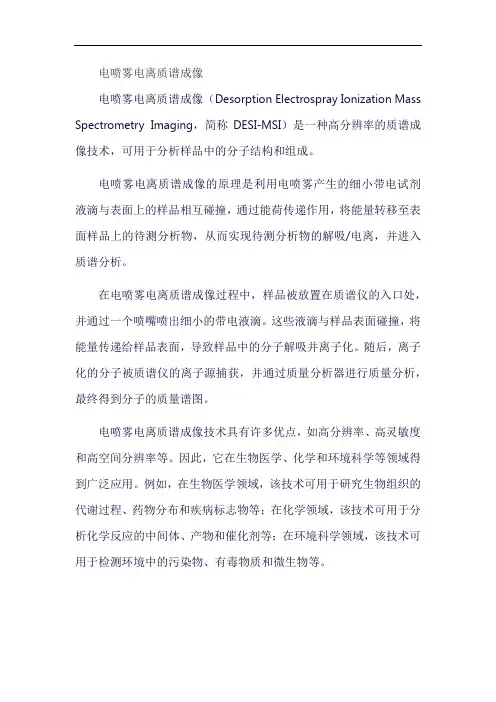
电喷雾电离质谱成像电喷雾电离质谱成像(Desorption Electrospray Ionization Mass Spectrometry Imaging,简称DESI-MSI)是一种高分辨率的质谱成像技术,可用于分析样品中的分子结构和组成。
电喷雾电离质谱成像的原理是利用电喷雾产生的细小带电试剂液滴与表面上的样品相互碰撞,通过能荷传递作用,将能量转移至表面样品上的待测分析物,从而实现待测分析物的解吸/电离,并进入质谱分析。
在电喷雾电离质谱成像过程中,样品被放置在质谱仪的入口处,并通过一个喷嘴喷出细小的带电液滴。
这些液滴与样品表面碰撞,将能量传递给样品表面,导致样品中的分子解吸并离子化。
随后,离子化的分子被质谱仪的离子源捕获,并通过质量分析器进行质量分析,最终得到分子的质量谱图。
电喷雾电离质谱成像技术具有许多优点,如高分辨率、高灵敏度和高空间分辨率等。
因此,它在生物医学、化学和环境科学等领域得到广泛应用。
例如,在生物医学领域,该技术可用于研究生物组织的代谢过程、药物分布和疾病标志物等;在化学领域,该技术可用于分析化学反应的中间体、产物和催化剂等;在环境科学领域,该技术可用于检测环境中的污染物、有毒物质和微生物等。
总之,电喷雾电离质谱成像技术是一种非常有用的分析工具,能够为我们提供关于样品分子结构和组成的详细信息,为科学研究和实际应用提供有力支持。
电喷雾电离质谱成像技术的主要优点包括:1.高分辨率:电喷雾电离质谱成像技术具有非常高的分辨率,能够对样品表面进行微米级别的分析,从而得到非常详细的空间分布信息。
2.高灵敏度:该技术对样品中的分子离子化效率非常高,因此即使在低浓度下也能够检测到目标分子,具有非常高的灵敏度。
3.无损分析:电喷雾电离质谱成像技术是一种非破坏性的分析方法,不需要对样品进行切片或处理,可以直接对样品表面进行分析,因此不会对样品造成损伤。
4.可视化分析:该技术可以将分子分布以图像的形式展示出来,使得分析结果更加直观和易于理解。
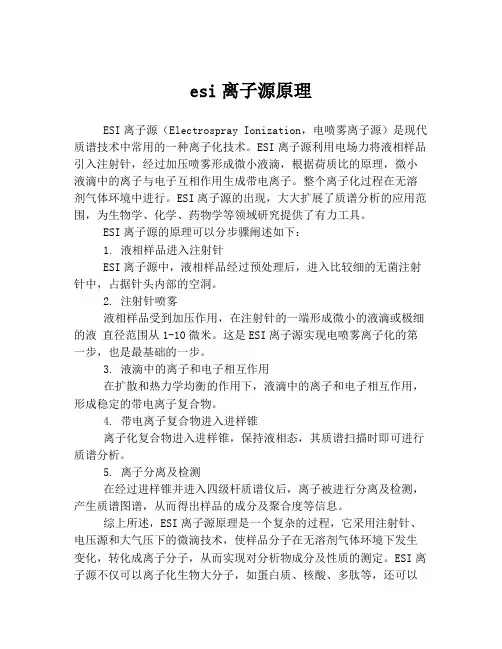
esi离子源原理ESI离子源(Electrospray Ionization,电喷雾离子源)是现代质谱技术中常用的一种离子化技术。
ESI离子源利用电场力将液相样品引入注射针,经过加压喷雾形成微小液滴,根据荷质比的原理,微小液滴中的离子与电子互相作用生成带电离子。
整个离子化过程在无溶剂气体环境中进行。
ESI离子源的出现,大大扩展了质谱分析的应用范围,为生物学、化学、药物学等领域研究提供了有力工具。
ESI离子源的原理可以分步骤阐述如下:1. 液相样品进入注射针ESI离子源中,液相样品经过预处理后,进入比较细的无菌注射针中,占据针头内部的空洞。
2. 注射针喷雾液相样品受到加压作用,在注射针的一端形成微小的液滴或极细的液直径范围从1-10微米。
这是ESI离子源实现电喷雾离子化的第一步,也是最基础的一步。
3. 液滴中的离子和电子相互作用在扩散和热力学均衡的作用下,液滴中的离子和电子相互作用,形成稳定的带电离子复合物。
4. 带电离子复合物进入进样锥离子化复合物进入进样锥,保持液相态,其质谱扫描时即可进行质谱分析。
5. 离子分离及检测在经过进样锥并进入四级杆质谱仪后,离子被进行分离及检测,产生质谱图谱,从而得出样品的成分及聚合度等信息。
综上所述,ESI离子源原理是一个复杂的过程,它采用注射针、电压源和大气压下的微滴技术,使样品分子在无溶剂气体环境下发生变化,转化成离子分子,从而实现对分析物成分及性质的测定。
ESI离子源不仅可以离子化生物大分子,如蛋白质、核酸、多肽等,还可以离子化溶剂中的小分子,为质谱分析提供了有力的工具。
ESI离子源的应用已经得到了广泛的应用,这为化学、生物、药物研究等领域提供了强有力的技术支持。
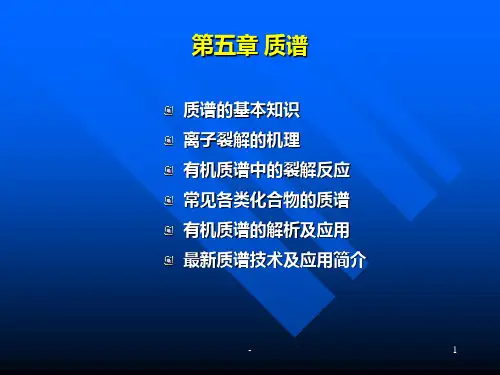
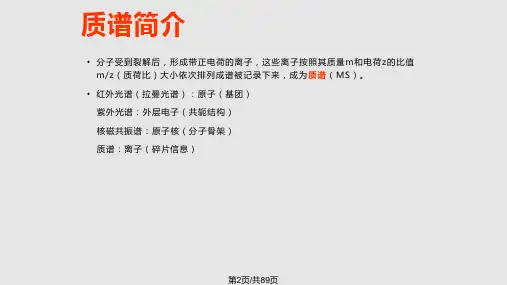
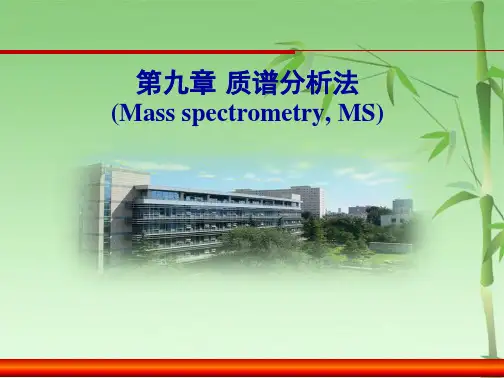
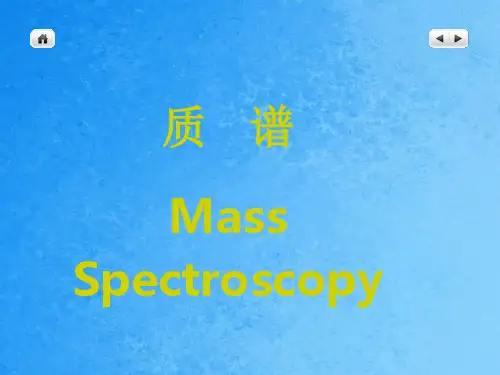

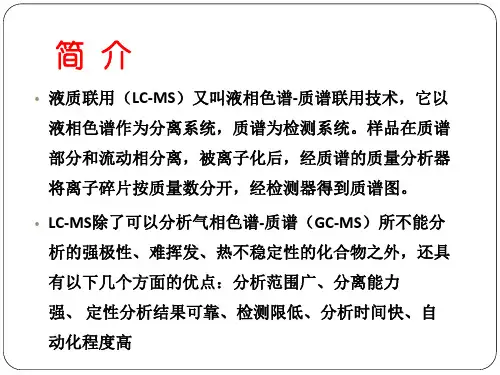
1Electrospray Ionization Mass Spectrometry
Jessica GilmanCourtney Mashburn
17 September 2002Chemistry 5181
“Many users tend to view ESI as a ‘Black Box,’ because sources of instability, background, interference, competition, and suppression are not always understood.”2
OutlinelIntroductionlIonization ProcesslIntroduction of Ions into MSlOperational Conditions and ParameterslSolvent and Analyte CharacteristicslSensitivity and Detection LimitslTandem TechniqueslSummary
IntroductionlESI allows for large, non-volatile molecules to be analyzed directly from the liquid phase
lUsed for:lMass determination of biomoleculeslAnalysis and sequencing of proteins and oligonucleotides
lAnalyzing drugs, pesticides, and carbohydrateslLong chain fatty acids3
ElectrosprayIonization ChamberAPI-Electrosprayoccurs at 760 torrProducts = neutrals, ions, and clusters of ions
Ionization MechanismslCoulomb Fission : lAssumes that the increased charge density, due to solvent evaporation, causes large droplets to divide into smaller droplets eventually leading to single ions.
lIon Evaporation: lAssumes the increased charge density that results from solvent evaporation causes Coulombicrepulsion to overcome the liquid’s surface tension, resulting in a release of ions from droplet surfaces4
Charging the AnalytelCharge SeparationlGas-phase ions are formed when the droplets from the Taylor Cone evaporate and the ions carrying excess charge are released into the gas-phase.lAdduct FormationlPolar molecules that do not have acidic or basic groups can be charged through formation of adducts with various ions.
lNegative ion ESI: form adducts with Cl-ions
lPositive ion ESI: form adducts with Na+, Li+, NH4+, or other cationic species
lProblem: High [salt] causes background interference.
Charging the Analyte, Cont’dlGas-Phase Reactions:lIonized at atmospheric pressure.lGenerally through gas-phase proton transfer.lProton goes to species with higher gas-phase proton affinity lAnalyte must have higher proton affinity than the solvent.lElectrochemRedoxRxns: l“The continuous flow of charge from the metallic contact to the sample solution must occur via an electrochemical reaction at that contact.”
lPositive ion ESI: oxidation
lNegative ion ESI: reduction5
Pneumatically-Assisted ESIlMust separate ions from neutrals and establish complete desolvation.
lUse a neutral sheath gaslAids in droplet formation and desolvation.lOff-Axis Positioning
lMax amount of desolvatedanalyte
lSelects against un-evaporated droplets
Introducing Ions into the MSlUse a dry N2“curtain” gas:
lCharged species penetrate the curtain because they are electrostaticallyattracted toward the orifice by an electric field gradient.
lUse a heated metal capillary interfacelAids in desolvationand declusteringof ions from neutrals.6
ESI Operating ConditionslESI operation depends on the ability to balance many variables simultaneously
lSelf-adjusted flow rate of samplelSelf-adjusted voltage between power supply and contact with solution
lCapillary tube parameters:
lNon-conductive: fused silica tubinglConductive: metalizedglass capillarieslInner diameter = flow ratelOuter diameter = Taylor cone
Instrumental ParameterslStable and effective ESI spray conditions:lTaylor cone has constant shapelConstant stream of droplets from Taylor cone
lNebulizinggas and solution flow rates
lApplied voltage, viscosity, and dielectric constantlDistance between spray capillary and counter electrode
lMethanol or pneumatic assistance is required
lHigh water content means high surface tensionlHigher voltages must be applied7
Analyte CharacteristicslSurface-active analyteshave a higher responselThey follow charge during fissioningprocesslESI response is directly related to:
lNonpolarsurface areal∆G transfer from NP to P solutionslReverse-phase HPLC retention time
lDifference between analyte pH and solvent pH
lIf low response, change the molecular structure
lDerivatitationcan make the analyte more easily charged or can increase the surface activity
Surface ActivitylEquimolaramounts and all other variables equal
lSurface–inactive = Cs+lSurface–active = DTMA+
lFor quantitative work, calibration curves, etc. must be employed
lIntensity of peak is not solely related to conc.